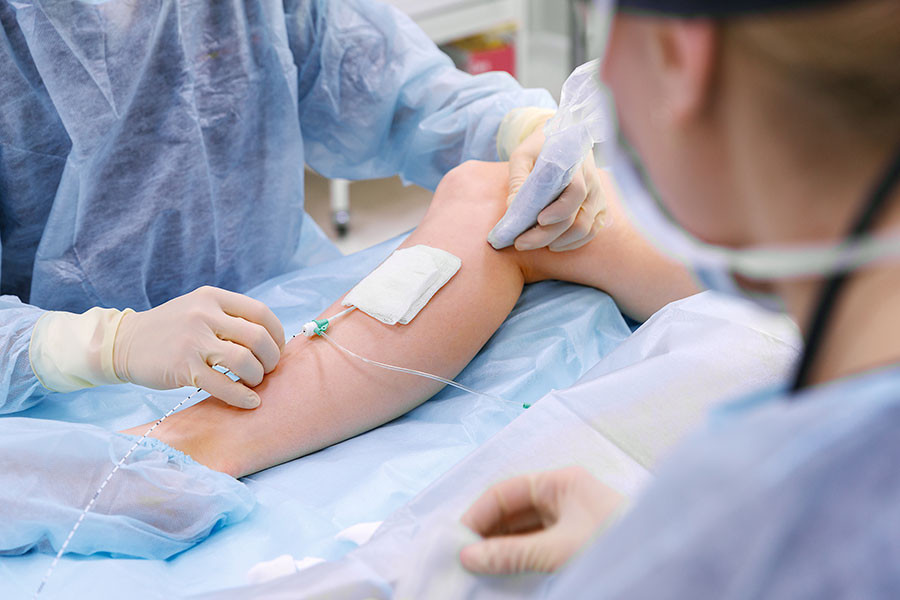About Vascular Surgery
Blood vessels are channels that are responsible in distributing blood throughout the entire body. The arteries transport oxygen-rich blood from the heart to whole body and the veins carry de-oxygenated blood from body tissues back to the heart. Generally speaking, vascular surgeons manage and handle all arterial and venous problems except those in the brain and those in and around the heart. Common vascular disorders include abdominal aortic aneurysm, aortic dissection, carotid artery disease, peripheral artery disease , lower limb ischaemia, diabetic foot, deep vein thrombosis, varicose vein and other chronic venous diseases. Vascular surgeons have specialised knowledge and experience in both open vascular and endovascular surgery. They also provide expertise in creating vascular access for haemodialysis and central venous access for chemotherapy. Therefore, besides treating a wide range of vascular diseases, vascular surgery also assumes an important role in the treatment provision of other specialties, including nephrology, oncology, orthopaedic surgery, spine surgery, trauma management etc.
Virtus Vascular Surgery Centre
Virtus Vascular Surgery Centre is dedicated to providing a comprehensive range of services to prevent and treat various vascular disorders and to minimize any devastating complication that could occur. Our multi-disciplinary team also partners with patients’ general practitioners and other specialists to ensure the timely delivery of evidence-based/multimodality treatments. Another point of note is that other than inpatient vascular surgery, we are also well-equipped to allow safe, efficient and quality day surgery services in our facility.

Virtus Medical Centre welcomes direct patient consultations and referrals from doctors and works closely with other specialists:
Direct consultation - Patient groups managed by the vascular surgery include:
- Pulsatile abdominal mass
- Incidental finding of abdominal/thoracic aneurysms during physical check-ups or imaging
- Peripheral arterial aneurysms
- Pseudoaneurysm after endovascular intervention
- Exercise-induced leg pain (Intermittent Claudication)
- Ischaemic rest pain
- Non-healing ischaemic ulcer
- Foot gangrene
- Peripheral artery disease screening
- Evaluation of the diabetic limb
- Carotid artery stenosis
- Prevent debilitating stroke after:
- Transient ischaemic attack/minor stroke
- Transient monocular visual lost (Amaurosis fugax)
- Varicose veins, spider veins
- Swollen leg or arm
- Non-healing venous ulcer
- Deep vein thrombosis
Abdominal/thoracic aortic aneurysm and dissection
Occlusive arterial disease of the lower limb
Carotid artery disease
Venous disease
Vascular tumours/vascular malformation
Collaboration with other specialists
- Creation of haemodialysis access for patient with severely impaired renal function with a predicted need for renal replacement therapy within the next few months
- Maintenance of arteriovenous access (AV fistula/AV graft): malfunction of the access, complication of the access, pseudoaneurysm, stenosis and aneurysmal dilatation
- Maintenance of permcath: suboptimal flow, catheter exchange, central vein stenosis
- Dialysis-related procedures
- Split catheter (permanent) insertion/removal for chronic haemodialysis
- Subclavian, jugular and femoral catheter insertion for acute haemodialysis
- Arrangement of AV fistula/graft creation
- Implantation of central venous access such as Hickman line, portacath
- Implantation of peripherally inserted central venous catheter
- Anterior/oblique retroperitoneal approach to the lumbar spine to gain direct access to the degenerated disc without having to manipulate any nerve
- Vascular reconstruction after En-Bloc removal of tumours
Nephrologist
Clinical oncologist and haematological oncologist
Neurosurgeon
Vascular trauma
- Aortic dissection
Referral from doctors for vascular assessment:
- Sudden weakness or paralysis of a leg, arm or one side of the face
- Sudden trouble in speaking or understanding speech
- Sudden loss of coordination or impaired balance
- Sudden/transient loss of vision
- Incidental finding of dilated or dissected abdominal aorta, thoracic aorta or visceral arteries
- A pulsating feeling in the abdomen, similar to a heartbeat
- Emboli causing pain, discolouration, or ulcers of the toes
- High-risk population, male smoker > 60 years old with family history of abdominal aortic aneurysm
- All diabetic foot ulcers
- Intermittent Claudication - pain, tightness, heaviness, cramping, or weak feeling that occurs in the legs during walking. The symptoms typically begin shortly after starting a walk, and go away a short time after rest
- Rest pain - Pain at fore-foot, worse at night, aggravated by elevation and relieved by dependency
- Non-healing ulcer or toe gangrene
- Swollen veins often look blue, bulging, and twisted
- Ankle swelling and tightness of the calf
- Heaviness, tiredness, restlessness or ache of legs. Standing or sitting for too long may worsen symptoms. Typically, symptoms are worse at the end of the day
- Skin changes, including eczema, ulcer and hyperpigmentation at the medial side of the lower leg
- Lower limb swelling inpatient at high risk for deep vein thrombosis
Symptoms that require carotid evaluation:
Symptoms that require aorta and iliac artery evaluation:
Symptoms that require arterial evaluation of the lower limb:
Symptoms that require venous evaluation of the lower limb:
Minimally Invasive Surgery
X-ray guided endovascular surgery (Arterial)
- Perpheral vascular disease:
- Percutaneous transluminal balloon angioplasty +/- stenting +/- thrombectomy +/- atherectomy - Renal/visceral artery stenosis/dissection:- Stenting
- Aortic dissection/aneurysm, thoracic, abdominal, thoracoabdominal, TEVAR, EVAR, Fenestrated/branched stent grafts
- Carotid angioplasty and stenting (Treatment of Carotid Stenosis)
X-ray guided endovascular surgery (Venous)
- IVC filter insertion/removal
- Venous stenting for venous occlusion/stenosis/DVT
- Venous thrombectomy using mechanical thrombectomy devices for DVT
- Central line insertion such as PICC, Hickman Line, Portacath
- Pelvic congestion syndrome- Ovarian and pelvic vein embolisation
<<Back to Specialty Services>>
Contact Us
| +852 8102 2022 | |
| CustomerCare@VirtusMedical.com | |
| 6/F, Virtus Medical Tower, 122 Queen's Road Central, Hong Kong |